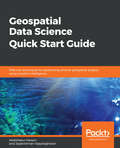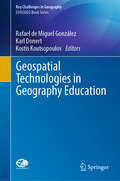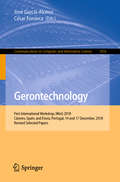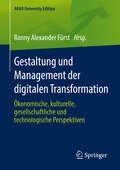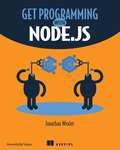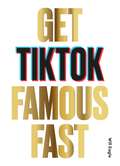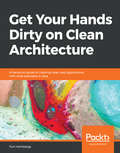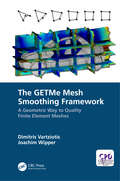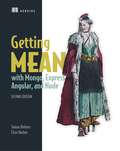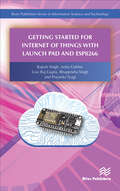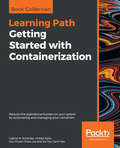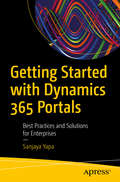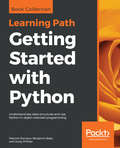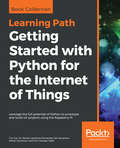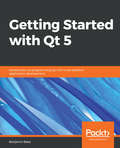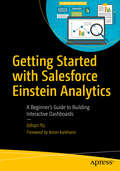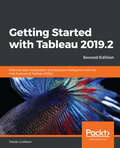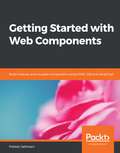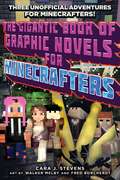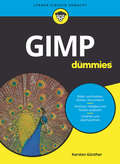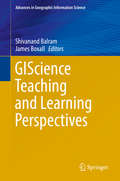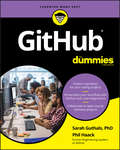- Table View
- List View
Geospatial Data Science Quick Start Guide: Effective techniques for performing smarter geospatial analysis using location intelligence
by Jayakrishnan Vijayaraghavan Abdishakur HassanDiscover the power of location data to build effective, intelligent data models with Geospatial ecosystemsKey FeaturesManipulate location-based data and create intelligent geospatial data modelsBuild effective location recommendation systems used by popular companies such as UberA hands-on guide to help you consume spatial data and parallelize GIS operations effectivelyBook DescriptionData scientists, who have access to vast data streams, are a bit myopic when it comes to intrinsic and extrinsic location-based data and are missing out on the intelligence it can provide to their models. This book demonstrates effective techniques for using the power of data science and geospatial intelligence to build effective, intelligent data models that make use of location-based data to give useful predictions and analyses.This book begins with a quick overview of the fundamentals of location-based data and how techniques such as Exploratory Data Analysis can be applied to it. We then delve into spatial operations such as computing distances, areas, extents, centroids, buffer polygons, intersecting geometries, geocoding, and more, which adds additional context to location data. Moving ahead, you will learn how to quickly build and deploy a geo-fencing system using Python. Lastly, you will learn how to leverage geospatial analysis techniques in popular recommendation systems such as collaborative filtering and location-based recommendations, and more.By the end of the book, you will be a rockstar when it comes to performing geospatial analysis with ease.What you will learnLearn how companies now use location dataSet up your Python environment and install Python geospatial packagesVisualize spatial data as graphsExtract geometry from spatial dataPerform spatial regression from scratchBuild web applications which dynamically references geospatial dataWho this book is forData Scientists who would like to leverage location-based data and want to use location-based intelligence in their data models will find this book useful. This book is also for GIS developers who wish to incorporate data analysis in their projects. Knowledge of Python programming and some basic understanding of data analysis are all you need to get the most out of this book.
Geospatial Technologies in Geography Education (Key Challenges in Geography)
by Rafael de Miguel González Karl Donert Kostis KoutsopoulosThis book addresses new pedagogies focusing on the use of geospatial technologies and geomedia in the classroom. Today, geospatial technologies are substantially influencing geography teaching and learning, particularly in secondary education. Web-GIS, virtual globes, storytelling, maps and apps for mobile devices are transforming the nature and design of geography curricula, instructional processes, didactics, resources and assessments. Undoubtedly, geography is among those school subjects that have benefited most from the implementation of new technologies in the classroom. Geospatial technologies can be used to develop inquiry-based learning or project-based learning pedagogies and help students to acquire spatial reasoning and spatial citizenship skills in the context of education for sustainable development.This book highlights a range of initiatives, projects and educational practices – from several European countries and settings – related to geospatial challenges in geography education. Given its scope, it will be equally appealing to scientists, students and teachers of geography and other fields using geospatial technologies and geomedia.
Gerontechnology: First International Workshop, IWoG 2018, Cáceres, Spain, and Évora, Portugal, 14 and 17 December, 2018, Revised Selected Papers (Communications in Computer and Information Science #1016)
by José García-Alonso César FonsecaThis book constitutes the thoroughly refereed post-conference proceedings of the First International Workshop on Gerotechnology, IWoG 2018, held in Cáceres, Spain on December 14, 2018, and in Évora, Portugal, on December 17, 2018. The 24 revised full papers along with 8 short papers presented were carefully reviewed and selected from 71 submissions.The papers are organized in topical sections on knowledge management for health: context, cognition, behavior and user modeling; technologies to increase the quality of life of the elderly population; Internet of Things (IoT); smarts technologies and algorithms for health; monitoring and management of chronic and non-chronic diseases;solutions for active aging, social integration and self-care; health interventions to support caregivers of elderly people; public health initiatives.
Gestaltung und Management der digitalen Transformation: Ökonomische, kulturelle, gesellschaftliche und technologische Perspektiven (AKAD University Edition)
by Ronny Alexander FürstDie Digitalisierung und der sich exponentiell entwickelnde technologische Fortschritt bahnen sich ihren Weg in alle Lebensbereiche einer globalisierten Welt - scheinbar völlig ungeachtet davon, wie dies von einzelnen Individuen und Gesellschaften wahrgenommen und bewertet wird. Manche fühlen sich als Verlierer und haben Ängste, von Robotern und künstlicher Intelligenz ersetzt zu werden, andere entdecken in der Zeitenwende neue Chancen und Perspektiven. Dies wirft zu den technologischen und ökonomischen Herausforderungen der digitalen Transformation zusätzliche kulturelle und gesellschaftliche Fragen auf. Beim 9. AKAD Forum der AKAD University diskutierten Wissenschaftler und Top-Manager das Leitthema „Digitale Transformation = soziale Revolution?“ In diesem Buch werden nun die Fachbeiträge der Experten aus Wirtschaft, Technik, Philosophie und Sprachwissenschaften einem breiteren Publikum vorgestellt. Nach einer theoretischen und praktischen Standortbestimmung werden Konzepte zum Management der digitalen Transformation aufgezeigt, durch die Digitalisierung induzierte soziale Entwicklungen diskutiert und der erforderliche Kompetenzwandel in der digitalen Arbeitswelt sowie neue Anforderungen an die Personalentwicklung beleuchtet und abschließend Zukunftsperspektiven abgeleitet. Lesenswert für alle, die die digitale Transformation verstehen und aktiv gestalten wollen!„Dieses Buch zeigt, wie es Unternehmen gelingt, ihre Geschäftsmodelle auf die digitale Zukunft vorzubereiten und wie dadurch Wettbewerbsvorteile geschaffen und Kunden-Anforderungen besser erfüllt werden können. Die theoretische Fundierung kombiniert mit vielen konkreten, praktischen Hinweisen und Fallbeispielen macht das Buch gleichermaßen lesenswert und nutzbar für Wissenschaftler und Praktiker aus unterschiedlichsten Branchen.“ Bernd Hake, Vorstand Hugo Boss AG
Get a Job, Creep: The Creeper Diaries, An Unofficial Minecrafters Novel, Book Ten (The Creeper Diaries #10)
by Greyson MannWhen Gerald’s parents decide it’s time for him to learn the value of an emerald, he sets out to get the perfect summer job. Wolf-walking, anyone? Baby-zombie-sitting? Llama grooming? Gerald isn’t exactly loving his options. When his mom starts selling vitamins and minerals, Gerald comes up with a sales idea of his own—a BIG idea. But he’s going to need some help. After he hires a few friends, they start raking in the emeralds. Gerald is going to be rich! He can see it already! But his fortune might come with a pretty big price tag, too.
Get Programming with Node.js
by Jonathan WexlerSummary Get Programming with Node.js teaches you to build web servers using JavaScript and Node. In this engaging tutorial, you'll work through eight complete projects, from writing the code for your first web server to adding live chat to a web app. Your hands will stay on the keyboard as you explore the most important aspects of the Node development process, including security, database management, authenticating user accounts, and deploying to production. You'll especially appreciate the easy-to-follow discussions, illuminating diagrams, and carefully explained code! Purchase of the print book includes a free eBook in PDF, Kindle, and ePub formats from Manning Publications. About the Technology Node.js delivers the speed and reliability you need for ecommerce, social media, and gaming applications. It comes with thousands of prebuilt packages to help you get started immediately. If you want to use JavaScript on the server, Node.js is your choice. What's inside New features from ES2015 and later Writing asynchronous code Creating data models Debugging JavaScript modules About the Reader Written for front-end web developers with intermediate JavaScript skills. Table of Contents GETTING SET UP Lesson 0 - Setting up Node.js and the JavaScript engine Lesson 1 - Configuring your environment Lesson 2 - Running a Node.js application UNIT 1 - GETTING STARTED WITH NODE.JS Lesson 3 - Creating a Node.js module Lesson 4 - Building a simple web server in Node.js Lesson 5 - Handling incoming data Lesson 6 - Writing better routes and serving external files Lesson 7 - Capstone: Creating your first web application UNIT 2 - EASIER WEB DEVELOPMENT WITH EXPRESS.JS Lesson 8 - Setting up an app with Express.js Lesson 9 - Routing in Express.js Lesson 10 - Connecting views with templates Lesson 11 - Configurations and error handling Lesson 12 - Capstone: Enhancing the Confetti Cuisine site with Express.js UNIT 3 - CONNECTING TO A DATABASE Lesson 13 - Setting up a MongoDB database Lssson 14 - Building models with Mongoose Lesson 15 - Connecting controllers and models Using promises with Mongoose Lesson 16 - Capstone: Saving user subscriptions UNIT 4 - BUILDING A USER MODEL Lesson 17 - Improving your data models Lesson 18 - Building the user model Lesson 19 - Creating and reading your models Lesson 20 - Updating and deleting your models Lesson 21 - Capstone: Adding CRUD models to Confetti Cuisine Creating controllers UNIT 5 - AUTHENTICATING USER ACCOUNTS Lesson 22 - Adding sessions and flash messages Lesson 23 - Building a user login and hashing passwords Lesson 24 - Adding user authentication Lesson 25 - Capstone: Adding user authentication to Confetti Cuisine UNIT 6 - BUILDING AN API Lesson 26 - Adding an API to your application Lesson 27 - Accessing your API from your application Lesson 28 - Adding API security Lesson 29 - Capstone: Implementing an API UNIT 7 - ADDING CHAT FUNCTIONALITY Lesson 30 - Working with Socket.io Lesson 31 - Saving chat messages Lesson 32 - Adding a chat notification indicator UNIT 8 - DEPLOYING AND MANAGING CODE IN PRODUCTION Lesson 33 - Capstone: Adding a chat feature to Confetti Cuisine Lesson 34 - Deploying your application Lesson 35 - Managing in production Lesson 36 - Testing your application Lesson 37 - Capstone: Deploying Confetti Cuisine
Get TikTok Famous Fast
by Will EagleGrab your phone and your friends and start making fame-worthy content today!Get TikTok Famous Fast is a bite-sized guide to building your own empire on TikTok and using it as a launchpad for your personal brand and media career.Top TikTok stars and industry insiders provide their tips on how be a hit, how to make your content the best possible, how to tap into the latest memes and trends, how to edit and - most importantly - how to grow your following.
Get TikTok Famous Fast
by Will EagleGrab your phone and your friends and start making fame-worthy content today!Get TikTok Famous Fast is a bite-sized guide to building your own empire on TikTok and using it as a launchpad for your personal brand and media career.Top TikTok stars and industry insiders provide their tips on how be a hit, how to make your content the best possible, how to tap into the latest memes and trends, how to edit and - most importantly - how to grow your following.
Get Your Hands Dirty on Clean Architecture: A hands-on guide to creating clean web applications with code examples in Java
by Tom HombergsGain insight into how hexagonal architecture can help to keep the cost of development low over the complete lifetime of an application Key Features Explore ways to make your software flexible, extensible, and adaptable Learn new concepts that you can easily blend with your own software development style Develop the mindset of building maintainable solutions instead of taking shortcuts Book Description We would all like to build software architecture that yields adaptable and flexible software with low development costs. But, unreasonable deadlines and shortcuts make it very hard to create such an architecture. Get Your Hands Dirty on Clean Architecture starts with a discussion about the conventional layered architecture style and its disadvantages. It also talks about the advantages of the domain-centric architecture styles of Robert C. Martin's Clean Architecture and Alistair Cockburn's Hexagonal Architecture. Then, the book dives into hands-on chapters that show you how to manifest a hexagonal architecture in actual code. You'll learn in detail about different mapping strategies between the layers of a hexagonal architecture and see how to assemble the architecture elements into an application. The later chapters demonstrate how to enforce architecture boundaries. You'll also learn what shortcuts produce what types of technical debt and how, sometimes, it is a good idea to willingly take on those debts. After reading this book, you'll have all the knowledge you need to create applications using the hexagonal architecture style of web development. What you will learn Identify potential shortcomings of using a layered architecture Apply methods to enforce architecture boundaries Find out how potential shortcuts can affect the software architecture Produce arguments for when to use which style of architecture Structure your code according to the architecture Apply various types of tests that will cover each element of the architecture Who this book is for This book is for you if you care about the architecture of the software you are building. To get the most out of this book, you must have some experience with web development. The code examples in this book are in Java. If you are not a Java programmer but can read object-oriented code in other languages, you will be fine. In the few places where Java or framework specifics are needed, they are thoroughly explained.
The GETMe Mesh Smoothing Framework: A Geometric Way to Quality Finite Element Meshes
by Dimitris Vartziotis Joachim WipperHigh quality meshes play a key role in many applications based on digital modeling and simulation. The finite element method is a paragon for such an approach and it is well known that quality meshes can significantly improve computational efficiency and solution accuracy of this method. Therefore, a lot of effort has been put in methods for improving mesh quality. These range from simple geometric approaches, like Laplacian smoothing, with a high computational efficiency but possible low resulting mesh quality, to global optimization-based methods, resulting in an excellent mesh quality at the cost of an increased computational and implementational complexity. <P><P>The geometric element transformation method (GETMe) aims to fill the gap between these two approaches. It is based on geometric mesh element transformations, which iteratively transform polygonal and polyhedral elements into their regular counterparts or into elements with a prescribed shape. GETMe combines a Laplacian smoothing-like computational efficiency with a global optimization-like effectiveness. The method is straightforward to implement and its variants can also be used to improve tangled and anisotropic meshes. <P><P>This book describes the mathematical theory of geometric element transformations as foundation for mesh smoothing. It gives a thorough introduction to GETMe-based mesh smoothing and its algorithms providing a framework to focus on effectively improving key mesh quality aspects. It addresses the improvement of planar, surface, volumetric, mixed, isotropic, and anisotropic meshes and addresses aspects of combining mesh smoothing with topological mesh modification. <P><P>The advantages of GETMe-based mesh smoothing are demonstrated by the example of various numerical tests. These include smoothing of real world meshes from engineering applications as well as smoothing of synthetic meshes for demonstrating key aspects of GETMe-based mesh improvement. Results are compared with those of other smoothing methods in terms of runtime behavior, mesh quality, and resulting finite element solution efficiency and accuracy. <P><P>Features: <li>Helps to improve finite element mesh quality by applying geometry-driven mesh smoothing approaches. <li>Supports the reader in understanding and implementing GETMe-based mesh smoothing. <li>Discusses aspects and properties of GETMe smoothing variants and thus provides guidance for choosing the appropriate mesh improvement algorithm. <li>Addresses smoothing of various mesh types: planar, surface, volumetric, isotropic, anisotropic, non-mixed, and mixed. <li>Provides and analyzes geometric element transformations for polygonal and polyhedral elements with regular and non-regular limits. <li>Includes a broad range of numerical examples and compares results with those of other smoothing methods.
Getting MEAN with Mongo, Express, Angular, and Node
by Simon Holmes clive harberSummaryGetting MEAN, Second Edition teaches you how to develop full-stack web applications using the MEAN stack. This edition was completely revised and updated to cover MongoDB 4, Express 4, Angular 7, Node 11, and the latest mainstream release of JavaScript ES2015.Purchase of the print book includes a free eBook in PDF, Kindle, and ePub formats from Manning Publications.About the TechnologyJuggling languages mid-application can radically slow down a full-stack web project. The MEAN stack—MongoDB, Express, Angular, and Node—uses JavaScript end to end, maximizing developer productivity and minimizing context switching. And you'll love the results! MEAN apps are fast, powerful, and beautiful.About the BookGetting MEAN, Second Edition teaches you how to develop full-stack web applications using the MEAN stack. Practical from the very beginning, the book helps you create a static site in Express and Node. Expanding on that solid foundation, you'll integrate a MongoDB database, build an API, and add an authentication system. Along the way, you'll get countless pro tips for building dynamic and responsive data-driven web applications! What's insideMongoDB 4, Express 4, Angular 7, and Node.js 11MEAN stack architectureMobile-ready web appsBest practices for efficiency and reusabilityAbout the ReaderReaders should be comfortable with standard web application designs and ES2015-style JavaScript.About the AuthorSimon Holmes and Clive Harber are full-stack developers with decades of experience in JavaScript and other leading-edge web technologies.Table of ContentsPART 1 - SETTING THE BASELINEIntroducing full-stack developmentDesigning a MEAN stack architecturePART 2 - BUILDING A NODE WEB APPLICATIONCreating and setting up a MEAN projectBuilding a static site with Node and ExpressBuilding a data model with MongoDB and MongooseWriting a REST API: Exposing the MongoDB database to the applicationConsuming a REST API: Using an API from inside ExpressPART 3 - ADDING A DYNAMIC FRONT END WITH ANGULARCreating an Angular application with TypeScriptBuilding a single-page application with Angular: FoundationsBuilding a single-page application with Angular: The next levelPART 4 - MANAGING AUTHENTICATION AND USER SESSIONSAuthenticating users, managing sessions, and securing APIsUsing an authentication API in Angular applications
Getting Started for Internet of Things with Launch Pad and ESP8266
by Rajesh Singh Anita Gehlot Lovi Raj Gupta Bhupendra Singh Priyanka TyagiGetting Started for Internet of Things with Launch Pad and ESP8266 provides a platform to get started with the Ti launch pad and IoT modules for Internet of Things applications. The book provides the basic knowledge of Ti launch Pad and ESP8266 based customized modules with their interfacing, along with the programming.The book discusses the application of Internet of Things in different areas. Several examples for rapid prototyping are included, this to make the readers understand the concept of IoT.The book comprises of twenty-seven chapters, which are divided into four sections and which focus on the design of various independent prototypes. Section-A gives a brief introduction to Ti launch pad (MSP430) and Internet of Things platforms like GPRS, NodeMCU and NuttyFi (ESP8266 customized board), and it shows steps to program these boards. Examples on how to interface these boards with display units, analog sensors, digital sensors and actuators are also included, this to make reader comfortable with the platforms. Section-B discusses the communication modes to relay the data like serial out, PWM and I2C. Section-C explores the IoT data loggers and shows certain steps to design and interact with the servers. Section-D includes few IoT based case studies in various fields. This book is based on the practical experience of the authors while undergoing projects with students and partners from various industries.
Getting Started with Containerization: Reduce the operational burden on your system by automating and managing your containers
by Hideto Saito Gabriel N. Schenker Hui-Chuan Chloe Lee Ke-Jou Carol HsuChoose the smarter way to learn about containerizing your applications and running them in production. Key Features Deploy and manage highly scalable, containerized applications with Kubernetes Build high-availability Kubernetes clusters Secure your applications via encapsulation, networks, and secrets Book Description Kubernetes is an open source orchestration platform for managing containers in a cluster environment. This Learning Path introduces you to the world of containerization, in addition to providing you with an overview of Docker fundamentals. As you progress, you will be able to understand how Kubernetes works with containers. Starting with creating Kubernetes clusters and running applications with proper authentication and authorization, you'll learn how to create high-availability Kubernetes clusters on Amazon Web Services (AWS), and also learn how to use kubeconfig to manage different clusters. Whether it is learning about Docker containers and Docker Compose, or building a continuous delivery pipeline for your application, this Learning Path will equip you with all the right tools and techniques to get started with containerization. By the end of this Learning Path, you will have gained hands-on experience of working with Docker containers and orchestrators, including SwarmKit and Kubernetes. This Learning Path includes content from the following Packt products: Kubernetes Cookbook - Second Edition by Hideto Saito, Hui-Chuan Chloe Lee, and Ke-Jou Carol Hsu Learn Docker - Fundamentals of Docker 18.x by Gabriel N. Schenker What you will learn Build your own container cluster Run a highly distributed application with Docker Swarm or Kubernetes Update or rollback a distributed application with zero downtime Containerize your traditional or microservice-based application Build a continuous delivery pipeline for your application Track metrics and logs for every container in your cluster Implement container orchestration to streamline deploying and managing applications Who this book is for This beginner-level Learning Path is designed for system administrators, operations engineers, DevOps engineers, and developers who want to get started with Docker and Kubernetes. Although no prior experience with Docker is required, basic knowledge of Kubernetes and containers will be helpful.
Getting Started with Dynamics 365 Portals: Best Practices and Solutions for Enterprises
by Sanjaya YapaUse the full range of features of Dynamics 365 Portal to develop and implement end user portals to provide your audience an online location to communicate and collaborate. This book guides you through implementation and highlights the best practices for each feature.Author Sanjaya Yapa begins with an introduction to end user portals in Dynamics 365 and takes you through a practical example that explains the features in detail. He then teaches you how the portal security works and best practices involved while configuring security such as local and federated authentication, web roles, and access rules. Helpful illustrations and directives guide you in setting up your portal with Dynamics 365 Customer Engagement (CE), basic customizations, content management, and web forms. You learn how to configure and manage document storage and learn about liquid templates, which is important when implementing custom web experiences for your end users. After reading this book, you will be able to implement a portal with Dynamics 365 CE and incorporate best practices in your enterprise-scale solutions.What You Will LearnSet up Dynamics 365 Portal within your Dynamics 365 instanceGet familiar with Portal Management Interface and its featuresKnow the security models and how to choose the best optionUse Entity Forms, lists, displaying charts, and customize PortalRefer to practical examples and case studies for developing and implementing advanced liquid templatesWho This Book Is ForDevelopers working in a Dynamics 365 CE environment
Getting Started with Python: Understand key data structures and use Python in object-oriented programming
by Fabrizio Romano Benjamin Baka Dusty PhillipsHarness the power of Python objects and data structures to implement algorithms for analyzing your data and efficiently extracting informationKey FeaturesTurn your designs into working software by learning the Python syntaxWrite robust code with a solid understanding of Python data structuresUnderstand when to use the functional or the OOP approachBook DescriptionThis Learning Path helps you get comfortable with the world of Python. It starts with a thorough and practical introduction to Python. You’ll quickly start writing programs, building websites, and working with data by harnessing Python's renowned data science libraries. With the power of linked lists, binary searches, and sorting algorithms, you'll easily create complex data structures, such as graphs, stacks, and queues. After understanding cooperative inheritance, you'll expertly raise, handle, and manipulate exceptions. You will effortlessly integrate the object-oriented and not-so-object-oriented aspects of Python, and create maintainable applications using higher level design patterns. Once you’ve covered core topics, you’ll understand the joy of unit testing and just how easy it is to create unit tests.By the end of this Learning Path, you will have built components that are easy to understand, debug, and can be used across different applications.This Learning Path includes content from the following Packt products:Learn Python Programming - Second Edition by Fabrizio RomanoPython Data Structures and Algorithms by Benjamin BakaPython 3 Object-Oriented Programming by Dusty PhillipsWhat you will learnUse data structures and control flow to write codeUse functions to bundle together a sequence of instructionsImplement objects in Python by creating classes and defining methodsDesign public interfaces using abstraction, encapsulation and information hidingRaise, define, and manipulate exceptions using special error objectsCreate bulletproof and reliable software by writing unit testsLearn the common programming patterns and algorithms used in PythonWho this book is forIf you are relatively new to coding and want to write scripts or programs to accomplish tasks using Python, or if you are an object-oriented programmer for other languages and seeking a leg up in the world of Python, then this Learning Path is for you. Though not essential, it will help you to have basic knowledge of programming and OOP.
Getting Started with Python for the Internet of Things: Leverage the full potential of Python to prototype and build IoT projects using the Raspberry Pi
by Tim Cox Dr. Steven Fernandes Sai Yamanoor Srihari Yamanoor Prof. Diwakar VaishBuild clever, collaborative, and powerful automation systems with the Raspberry Pi and Python.Key FeaturesCreate your own Pi-Rover or Pi-Hexipod robotsDevelop practical applications in Python using Raspberry PiBuild your own Jarvis, a highly advanced computerized AIBook DescriptionThis Learning Path takes you on a journey in the world of robotics and teaches you all that you can achieve with Raspberry Pi and Python.It teaches you to harness the power of Python with the Raspberry Pi 3 and the Raspberry Pi zero to build superlative automation systems that can transform your business. You will learn to create text classifiers, predict sentiment in words, and develop applications with the Tkinter library. Things will get more interesting when you build a human face detection and recognition system and a home automation system in Python, where different appliances are controlled using the Raspberry Pi. With such diverse robotics projects, you'll grasp the basics of robotics and its functions, and understand the integration of robotics with the IoT environment.By the end of this Learning Path, you will have covered everything from configuring a robotic controller, to creating a self-driven robotic vehicle using Python.Raspberry Pi 3 Cookbook for Python Programmers - Third Edition by Tim Cox, Dr. Steven Lawrence FernandesPython Programming with Raspberry Pi by Sai Yamanoor, Srihari YamanoorPython Robotics Projects by Prof. Diwakar VaishWhat you will learnBuild text classifiers and predict sentiment in words with the Tkinter libraryDevelop human face detection and recognition systemsCreate a neural network module for optical character recognitionBuild a mobile robot using the Raspberry Pi as a controllerUnderstand how to interface sensors, actuators, and LED displays workApply machine learning techniques to your modelsInterface your robots with BluetoothWho this book is forThis Learning Path is specially designed for Python developers who want to take their skills to the next level by creating robots that can enhance people’s lives. Familiarity with Python and electronics will aid understanding the concepts in this Learning Path.
Getting Started with Qt 5: Introduction to programming Qt 5 for cross-platform application development
by Benjamin BakaBegin writing graphical user interface(GUI) applications for building human machine interfaces with a clear understanding of key concepts of the Qt frameworkKey FeaturesLearn how to write, assemble, and build Qt application from the command lineUnderstand key concepts like Signals and Slots in QtBest practices and effective techniques for designing graphical user interfaces using Qt 5Book DescriptionQt is a cross-platform application framework and widget toolkit that is used to create GUI applications that can run on different hardware and operating systems. The main aim of this book is to introduce Qt to the reader. Through the use of simple examples, we will walk you through building blocks without focusing too much on theory.Qt is a popular tool that can be used for building a variety of applications, such as web browsers, media players such as VLC, and Adobe Photoshop. Following Qt installation and setup, the book dives straight into helping you create your first application.You will be introduced to Widgets, Qt's interface building block, and the many varieties that are available for creating GUIs. Next, Qt's core concept of signals and slots are well illustrated with sufficient examples. The book further teaches you how to create custom widgets, signals and slots, and how to communicate useful information via dialog boxes. To cap everything off, you will be taken through writing applications that can connect to databases in order to persist data.By the end of the book, you should be well equipped to start creating your own Qt applications and confident enough to pick up more advanced Qt techniques and materials to hone your skills.What you will learnSet up and configure your machine to begin developing Qt applications Discover different widgets and layouts for constructing UIsUnderstand the key concept of signals and slots Understand how signals and slots help animate a GUIExplore how to create customized widgets along with signals and slots Understand how to subclass and create a custom windows applicationUnderstand how to write applications that can talk to databases.Who this book is forAnyone trying to start development of graphical user interface application will find this book useful. One does not need prior exposure to other toolkits to understand this book. In order to learn from this book you should have basic knowledge of C++ and a good grasp of Object Oriented Programming. Familiarity with GNU/Linux will be very useful though it's not a mandatory skill.
Getting Started with Salesforce Einstein Analytics: A Beginner’s Guide to Building Interactive Dashboards
by Johan YuBuild interactive dashboards using Salesforce Einstein analytics. Explore all of your data quickly and easily by providing AI-powered advanced analytics, right in Salesforce. You will manage datasets, query data with Salesforce Analytics Query Language (SAQL), and customize dashboards.Because Einstein Analytics is new, the curve to learn this technology can be difficult. This book guides you step-by-step in simple, easy-to-understand terms to get data from the Salesforce platform to the Einstein Analytics platform and also shows you how to import external data (e.g., CSV files). Core chapters focus on understanding data sources, dataflow, dataset, and lens leading up to building dashboards from scratch. Advanced features such as data transformation using computeExpression and computeRelative as well as dataflow with a multi-value lookup are explored. What You Will Learn Use data from Salesforce and external sourcesCreate a dataflow to build a flexible datasetBuild dashboards using Einstein AnalyticsExplore and analyze data using Einstein AnalyticsUtilize SAQL and binding to create advance dashboards Who This Book Is For IT users getting started with Einstein Analytics, Salesforce consultants starting new Einstein Analytics projects, and power users familiar with Salesforce reporting and dashboards who want to get up to speed on new analytics features
Getting Started with Tableau 2019.2: Effective data visualization and business intelligence with the new features of Tableau 2019.2, 2nd Edition
by Tristan GuillevinLeverage the power of Tableau 2019.1’s new features to create impactful data visualizationKey FeaturesGet up and running with the newly released features of Tableau 2019.1Create enterprise-grade dashboard and reports to communicate your insights effectivelyBegin your Tableau journey by understanding its core functionalitiesBook DescriptionTableau is one of the leading data visualization tools and is regularly updated with new functionalities and features. The latest release, Tableau 2019.1, promises new and advanced features related to visual analytics, reporting, dashboarding, and a host of other data visualization aspects. Getting Started with Tableau 2019.1 will get you up to speed with these additional functionalities.The book starts by highlighting the new functionalities of Tableau 2019.1, providing concrete examples of how to use them. However, if you're new to Tableau, don’t worry – you’ll be guided through the major aspects of Tableau with relevant examples. You'll learn how to connect to data, build a data source, visualize your data, build a dashboard, and even share data online. In the concluding chapters, you'll delve into advanced techniques such as creating a cross-database join and data blending.By the end of this book, you will be able to use Tableau effectively to create quick, cost-effective, and business-efficient Business Intelligence (BI) solutions.What you will learnDiscover new functionalities such as ‘Ask Data’, the new way to interact with your data using natural languageConnect tables and make transformations such as pivoting the field and splitting columnsBuild an efficient data source for analysisDesign insightful data visualization using different mark types and propertiesDevelop powerful dashboards and stories Share your work and interact with Tableau ServerUse Tableau to explore your data and find new insightsExplore Tableau's advanced features and gear up for upcoming challengesWho this book is forExisting Tableau users and BI professionals who want to get up to speed with what's new in Tableau 2019 will find this beginner-level book to be a very useful resource. Some experience of Tableau is assumed, however, the book also features introductory concepts, which even beginners can take advantage of.
Getting Started with Web Components
by Prateek JadhwaniThis book is intended for web developers who wish to build reusable components for their modern web applications regardless of their experience with any web framework. The books assume working knowledge of HTML, CSS, and JavaScript.
The Gigantic Book of Graphic Novels for Minecrafters: Three Unofficial Adventures
by Cara StevensPackaged Together for the First Time, the First Three Installments of Sky Pony’s Redstone Junior High Series! When quiet farm girl Pixel receives an acceptance letter from the prestigious academy for gifted students, Redstone Junior High, she is thrilled! Little does Pixel know that the school's long history of safety is about to take an unsettling turn. The adventures that unfold will test Pixel's courage, reveal a unique and precious gift that she never knew she had, and help her create friendships that will change the course of her life. This bind up contains the following graphic novels: Zombies Ate My HomeworkCreepers Crashed My PartyDragons Never DieThe Gigantic Book of Graphic Novels for Minecrafters will enchant readers of all ages who love playing Minecraft and love stories full of action, adventure, and bravery. <P><P> <i>Advisory: Bookshare has learned that this book offers only partial accessibility. We have kept it in the collection because it is useful for some of our members. Benetech is actively working on projects to improve accessibility issues such as these.</i>
GIMP für Dummies (Für Dummies)
by Karsten W. GüntherDieses Buch befasst sich mit den Grundlagen der Bildbearbeitung und von GIMP: Docks, Werkzeuge, Filter, Auswahlen, Ebenen und Pfade werden Ihnen bald sehr vertraut sein. Sie wollen Bilder verbessern und kombinieren oder gar neue Bilder erzeugen? Mit GIMP kein Problem. Sie sind sicher, dass GIMP eine bestimmte Funktionalität hat, wissen aber nicht, wo suchen? Schlagen Sie in diesem Buch nach! Für Fortgeschrittene bietet es zudem noch jede Menge Tipps zu Spezialeffekten, zum zerstörungsfreien Arbeiten, zum Schärfen und Weichzeichnen und zu vielen anderen Dingen, die bei der Bildbearbeitung Spaß machen.
Girl Gone Viral
by Arvin AhmadiPerfect for fans of Warcross and Black Mirror, Girl Gone Viral is the inventive and timely story of a seventeen-year-old coder's catapult to stardom.For seventeen-year-old Opal Hopper, code is magic. She builds entire worlds from scratch: Mars craters, shimmering lakes, any virtual experience her heart desires. But she can't code her dad back into her life. When he disappeared after her tenth birthday, leaving only a cryptic note, Opal tried desperately to find him. And when he never turned up, she enrolled at a boarding school for technical prodigies and tried to forget.Until now. Because WAVE, the world's biggest virtual reality platform, has announced a contest where the winner gets to meet its billionaire founder. The same billionaire who worked closely with Opal's dad. The one she always believed might know where he went. The one who maybe even murdered him.What begins as a small data hack to win the contest spirals out of control when Opal goes viral, digging her deeper into a hole of lies, hacks, and manipulation. How far will Opal go for the answers--or is it the attention--she's wanted for years?
GIScience Teaching and Learning Perspectives (Advances in Geographic Information Science)
by Shivanand Balram James BoxallThis volume uniquely links educational theories and the practice of GIScience in higher education contexts to guide classroom practice, present effective practical implementations from peers, and provide resources and strategies for effective teaching methods. The book offers a comprehensive exploration of GIScience education, including current trends and future educational needs in GIScience, and will act as a resource to prepare learners for a world that demands more intensive investment in present-day education and technological literacy. Additionally, the indirect benefit of merging the fragmented literature on GIScience literacy will provide a basis to examine common techniques and enable a new wave of research more rooted in learning theories. In ten chapters, the book is designed to attract an audience from geographic information systems science, geomatics, spatial information science, cartography, information technology, and educational technology as focus disciplines.
GitHub For Dummies
by Guthals Phil HaackCode collaboratively with GitHub Once you’ve learned the basics of coding the next step is to start sharing your expertise, learning from other coding pros, or working as a collaborative member of development teams. GitHub is the go-to community for facilitating coding collaboration, and GitHub For Dummies is the next step on your journey as a developer. Written by a GitHub engineer, this book is packed with insight on how GitHub works and how you can use it to become a more effective, efficient, and valuable member of any collaborative programming team. Store and share your work online with GitHub Collaborate with others on your team or across the international coding community Embrace open-source values and processes Establish yourself as a valuable member of the GitHub community From setting up GitHub on your desktop and launching your first project to cloning repositories, finding useful apps on the marketplace, and improving workflow, GitHub For Dummies covers the essentials the novice programmer needs to enhance collaboration and teamwork with this industry-standard tool.
